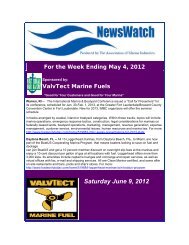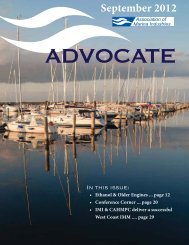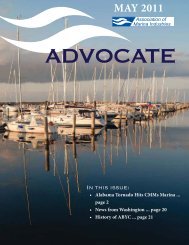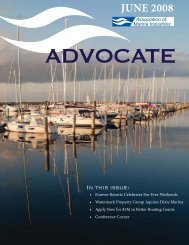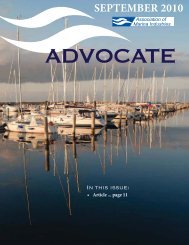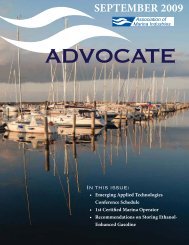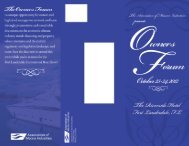NOVEMBER 2010 - Association of Marina Industries
NOVEMBER 2010 - Association of Marina Industries
NOVEMBER 2010 - Association of Marina Industries
- No tags were found...
Create successful ePaper yourself
Turn your PDF publications into a flip-book with our unique Google optimized e-Paper software.
7Question: Since E-10 attracts water, is it important to installa water separator to prevent the water reaching the engine?Answer: Unlike regular gasoline, which can absorb almostno moisture, E-10 can hold up to ½ percent <strong>of</strong> water by volume,and the water molecules will dissolve in the fuel. Thesolubilized water will bypass the water separator and burnharmlessly through the engine. Only if phase separationwere to occur would a water separator do its job, but bythen the fuel itself would be the problem. Phase-separatedgasoline consists <strong>of</strong> a water/ethanol mixture on the bottom<strong>of</strong> the tank and reduced-octane gasoline floating at the top,either <strong>of</strong> which will damage your engine.Note, however, that a fuel filter (10-micron) is essential tokeep gunk from reaching your engine. Ethanol is a solventthat dissolves resins, rust and dirt that have accumulatedon older tank walls. Especially when you first make thetransition to E-10, it is important to carry spare filters anda galvanized bucket to store used filters prior to disposal.Even in new engines and tanks, E-10 will sometimes forma mysterious gooey substance that will also clog filters.Richard Kolb, the manager <strong>of</strong> Emissions and Regulationsfor Volvo Penta, believes the goo is caused by water mixingwith one or more <strong>of</strong> the 108 approved compounds that canbe used in gasoline. These compounds vary among suppliers,so one solution is to change to a different brand <strong>of</strong>gasoline. Another is to use carburetor cleaner, which hesays has sometimes remedied the problem.Question: Are there additives that will prevent phase separation?Answer: Both Gibbs and Simnick said that the additivesthat eliminate water may work incrementally to protectagainst phase separation, but as Jim Simnick said there isno additive that will stand up to a good slug <strong>of</strong> water.Curiously, if E-15 were to be allowed, it would be less proneto phase separation than E-10 since the additional alcoholwould absorb more water. That’s the good news. But—thebad news--adding more ethanol raises other issues withmaterials compatibility: elastomers, plastics and metalsmay be affected because alcohol is more corrosive thangasoline and engines have only been tested with E-10. Also,adding oxygen in the fuel may cause the engine to run hotter,especially if a computer does not control combustion.***********Bob Adriance is editor <strong>of</strong> Seaworthy, the BoatU.S. DamageAvoidance publication that is based on real insuranceclaims. Bob is also the Author <strong>of</strong> Seaworthy, EssentialLessons from BoatU.S. 20-Year Case File <strong>of</strong> ThingsGone Wrong published by McGraw-Hill/InternationalMarine.GOINGGREENThis month’s feature: Protect WaterwaysThis month’s tip brought to you by Elizabeth LaPorte atMI Sea Grant http://www.miseagrant.umich.edu• Restrict all maintenance to designated areas, ideally100 feet or more from water, to contain or eliminatepollutants—no debris should be allowed to enterany waterways.• Contaminants from hull maintenance are moreeasily contained on land.• Maintenance areas should be paved and shelteredfrom rain to prevent debris from entering waterwaysfrom run<strong>of</strong>f.• Post signs, such as “Maintenance Area for Stripping,Fiberglass Repair, and Spray Painting.”• If a hard surface maintenance area is not practical,perform maintenance work over tarps or filter fabricto collect paint chips and other debris. Filter fabricallows water to pass through, unlike plastic.• Post fliers with maintenance guidelines for boatowners and contractors throughout the boatyard,such as “Use plant-based solvents and green cleaningproducts.”• Use drip pans when handling any type <strong>of</strong> liquid, and useseparate drip pans for each fluid to avoid mixing.• Use funnels to transfer all fluids, particularlypetroleum-based strippers and solvents.• Allow solids in used strippers and thinners to settle,making solvents reusable.• Use only one cleaning solvent to simplify disposal.• Use only the minimal amount <strong>of</strong> solvent needed.Lew Gibbs says the best way to prevent phase separation inE-10 is to “keep it dry, keep it dry, keep it dry.” That meanskeeping the tank filled to prevent condensation.Pour solvent into a small container for smaller jobs.



